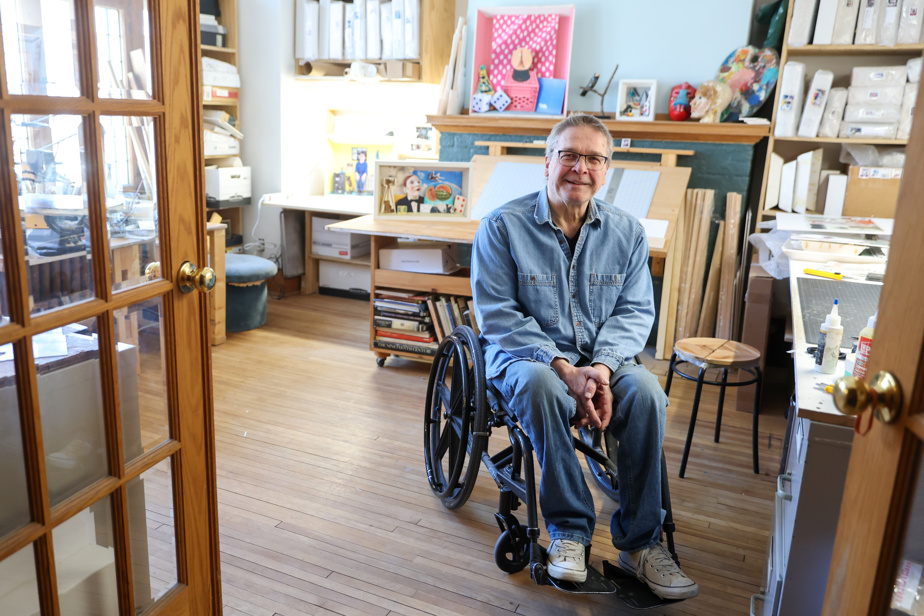His journey
David Elliott had come to Montreal to do his master’s degree at Concordia. “It was cheap to live here and I like both cultures,” he says. After meeting his wife, Elise Bernatchez, with whom he had four children, he became an artist and teacher (for 40 years) at this university.
Inspired during his adolescence by the London Regionalism movement of Jack Chambers or Greg Curnoe, he turned to figuration and the popular image when abstraction and formalism were at their zenith. “In Quebec, the only one who corresponded to what I intrinsically loved was Edmund Alleyn,” he says.

PHOTO FRANÇOIS ROY, THE PRESS
The work of Jack Chambers that encouraged him to become an artist.
Poetic, his works are part of museum collections – the Montreal Museum of Fine Arts, the Montreal Museum of Contemporary Art, the National Museum of Fine Arts of Quebec, the Nova Scotia Museum and the Pointe-à-Callière Museum. . Recently, the Canada Council for the Arts acquired Studio w Typewriter & Squirrelsa work from 2021. However, it was the Museo de Arte Moderno in Mexico City that organized his only retrospective, in 1993. No museum here offered him this chance.

PHOTO PROVIDED BY THE ARTIST
His solo at the Museo de Arte Moderno, in Mexico City
Long represented by Joyce Yahouda, he now does business with gallery owner Nicolas Robert. He is also a curator and author. He published an article on Philip Guston in 2020 in the revered magazine Border Crossings and, last year, he organized an exhibition on R. Holland Murray at the Guido Molinari Foundation.
Its boxes
In the 1980s, David Elliott created large canvases, often after making preparatory models. It is therefore natural that he has turned to 3D collage cases in recent years. A practice that also stems from problems related to polio, contracted in his youth. The weakness of his nervous system forces him to work sitting down and has weakened his arms. But not his morale or his determination!

PHOTO PROVIDED BY THE ARTIST
David Elliott in his studio on rue Delisle, in 1981.
“When you’re young, your body pretends everything is okay, so I walked on crutches, climbed stairs and up ladders,” he says. Today, this is no longer possible. I made myself a workshop where everything is at my level. I can put my arms down while I’m cutting, for example. »
-

PHOTO FRANÇOIS ROY, THE PRESS
David Elliott holding one of his collage boxes
-

PHOTO FRANÇOIS ROY, THE PRESS
One of its boxes dedicated to Ukraine
1/2
His boxes allow him to speak as much about current events as about personal experiences. “There is an intimacy in my boxes that there was not in my canvases,” he says. My boxes have also evolved. They are now more detailed. »
His studio
David Elliott left his studio at 305 rue de Bellechasse during the pandemic. His current workshop is on the ground floor of his house. A workshop with works everywhere. Those in the process of being created, others recent and others older.

PHOTO FRANÇOIS ROY, THE PRESS
David Elliott cuts out a paper figurine that will go into one of his collage boxes.
He creates with Photoshop, makes prints and a lot of DIY, to cut, paste and fix his images in the boxes. He has always been a handyman. “At the end of high school, I was doing cutouts in the basement at my parents’ house, all by myself! he says. Very early on, the studio became a refuge for him, artistic as well as personal.
-

PHOTO FRANÇOIS ROY, THE PRESS
The cut corner
-

PHOTO FRANÇOIS ROY, THE PRESS
A view of his studio
1/2
His projects
David Elliott decided to pay homage to the workshops he had in the past. When he arrived in Montreal, it was rue Saint-Pierre. In 1978, he transferred it to rue Peel, near Wellington. From 1980 to 1995, he worked at 2247, rue Delisle, in Little Burgundy. Then, from 1996 to 2020, in the mythical 305, rue de Bellechasse.
“For short periods, for financial or family reasons, I worked for us, rue Marcil, in 1979 and 1980, then rue Oxford, in 1986-1987. I also did two international residencies. In 2010 in a studio in New York and in 2013 at the Cité des arts in Paris. »

PHOTO PROVIDED BY THE ARTIST
Workshop with sound system2023, 17 inches x 27 inches
David Elliott is exhibiting his works this weekend in Nicolas Robert’s booth at the Plural fair in Old Montreal, including his box Workshop with sound systemwhich represents the atmosphere of the studio he shared with his ex-pupil Nicolas Grenier at 305, rue de Bellechasse.
As he turns 70 in June, he continues to savor his happiness in creating which has never left him. He took up photography and feels more free than ever. “I’m spoiled,” he said. I’m in the middle-end of my career, so I do what I want! When I was young, I needed to come to terms with polio, and all my life, obstacles have been the norm. So today is fine! »
In pictures
-

PHOTO PROVIDED BY THE ARTIST
Rare Painting1982, oil on canvas, 173 x 203 cm
-

PHOTO RICHARD-MAX TREMBLAY, PROVIDED BY THE ARTIST
Fall, 2007, oil on canvas, 234 x 422 cm. MACM collection.
-

PHOTO PROVIDED BY THE ARTIST
Studio w Typewriter & Squirrels2021, collage with printed paper, cardboard, foam, wood and acrylic, 48.3 x 61 cm
1/3
